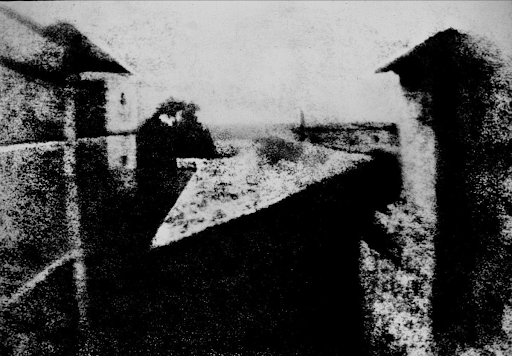The year is 1826. Joseph Nicéphore Niépce takes a heated plate out of his homemade “camera obscura” and observes the result. Over the more than eight hours Niépce had waited, bitumen (asphalt) with light-sensitive properties had gradually hardened over the areas which had received more sunlight through his camera. When Niépce treats the result with certain chemicals, unhardened bits with less exposure to sunlight are shown to have fallen off, while the asphalt pieces with the most sunlight exposure remain, creating an inverted image of the outside world. The first photograph has been taken, marking a technological innovation which will remain integral to society almost 200 years in the future. But how is this possible?
The basic concept of a camera dates back over 2000 years, although they were completely different from what we picture today. The modern word camera comes from “camera obscura,” which translates to dark chamber. Early philosophers such as Mo-tzu in 400 BC noted that if a small hole was placed in a wall separating a dark room from the outside, an inverted image of the outside would be created by the light. Overtime, this concept developed; cloths were used to depict the inverted image, scholars began to learn how the effect was caused by light rays, and artists such as DaVinci started to use this effect within their artworks.
When Niépce quit his administrative position to pursue a career in science, he learned of the camera obscura effects, and learned of the first primitive cameras. These had replicated the camera obscura effect with a dark box containing a mirror angled upwards, which would reflect the image through tracing paper on the other side. While Niépce did not greatly change the physical structure of the camera, Niépce was determined to find a way to permanently keep its image intact. Using his knowledge of light properties, he eventually came to create a film of a bitumen mix, which when placed where the tracing paper usually went created photographs. The first photographic camera had been developed.
Eventually, Niépce began working with scientist Jacques-Mandé Daguerre to develop an improved, fully automatic camera. Together, they found that a silver iodide mixed with a salt solution was far more effective at producing clear images, with these types of cameras being called Daguerreotypes. Soon after Niépce died, but in 1839 Alphonso Giroux struck a deal with Daguerre and Niépce’s son to create the first mass-produced photographic camera.
These Daguerreotype cameras were great technological strides, but they severely lacked practicality. The exposure time was up to thirty minutes, they were as large as a medium-sized dog, and at the equivalent of tens of thousands of dollars in today’s money they were completely unaffordable to the general public. Gradually, improvements from various scientists were made in these regards. In 1841, Charles Chevalier developed a vastly improved camera, which brought exposure times down to 2-3 minutes, had a foldable back which allowed for more portability, and was considerably cheaper. In the following decade, Daguerreotype cameras faded out of popularity, and were replaced by wet-plate cameras, where thin sheets of iron or glass were coated in a solution and placed in the camera while still wet. Although the process was certainly improved, it was still quite inconvenient. A few improvements were made over the next 30 years, such as a prism lens to prevent photographs from being inverted, and increasingly shorter exposure times, but a company named Kodak would come and drastically change the photographic process.
In 1888, the first camera with photographic film was created by the Kodak company. It offered the film necessary for 100 exposures before needing to be sent back to receive more film. With its much reduced cost and decreased size due to its simplistic and electric process for transcribing photographs, the average person could now easily acquire a camera, catapulting a period of rapid improvement within the industry.
The greater influx of photographers increased the need for high-quality but still cheap and easily-produced cameras. In the early 20th century, a higher-quality 35mm film became the standard, allowing for photographs with much sharper resolutions. Specialized cameras permitted continuous recording, allowing for movies and television to be created, and allowing for entire events to be captured with cameras, rather than just a single moment. In 1949, the first instant camera was developed by Polaroid, which completely eliminated the need for lengthy exposures. By this point, it was considered standard for every American family to own at least one camera. In the 1990’s, digital cameras entirely eliminated the need for film by storing the photographs on a memory card or another form of digital storage. Now, there were practically no limitations on how many photos could be taken with a camera without additional cost. Adjustable features such as multiple customisable lenses and the ability to automatically change lighting continue to improve to this day, as the camera we all are familiar with continues to improve in small increments.
Many people still think that a camera has always been described as a machine which we use to capture photographs. However, this is far from the truth. The idea of a camera has continuously changed over time, evolving from the concept by which light entering a room would reflect an inverted image, all the way to the modern photographic cameras which dominate our society today. As we continue to see our cameras develop, know that these accomplishments were only made possible by the continuous collaboration of thousands of scientists all throughout human history.


